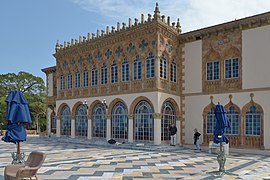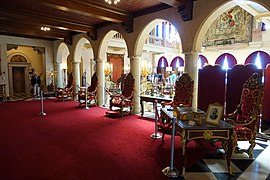Ca' d'Zan
Cà d'Zan | |
 Cà d'Zan - the bay front façade of the living room on the western elevation showing part of the marble terrace | |
| Location | Sarasota, Florida |
|---|---|
| Coordinates | 27°22′59″N 82°33′53″W / 27.38306°N 82.56472°W |
| Area | 36,000 square feet |
| Architectural style | Mediterranean revival style |
| Part of | Caples'-Ringlings' Estates Historic District (ID82001039[1]) |
| Designated CP | 15 December 1982 |
Cà d'Zan (/kɑːˌdə.zɑːn/) is a Mediterranean revival residence in Sarasota, Florida, adjacent to Sarasota Bay. Cà d'Zan was built in the mid-1920s as the winter retreat of the American circus mogul, entrepreneur, and art collector John Ringling and his wife Mable Burton Ringling. The name Cà d'Zan means "House of John" in the Venetian language; in Italian it would be "Casa di Giovanni".
Built in 1926 by Owen Burns,[2] Cà d'Zan features an eclectic array of architectural styles including Venetian Gothic, Italian Renaissance, Moorish, and Spanish-inspired elements drawn from different historic periods.[3] Mable and John Ringling had visited Venice, which inspired the Venetian Gothic influence in the house, prominently seen in a variety of architectural elements such as windows with Gothic arches and terra cotta ornament replicating Gothic tracery.
Description and history[edit]

Mable and John Ringling first came to Sarasota in 1909 and purchased their waterfront estate in 1911 from Mary Louise and Charles N. Thompson, who owned Shell Beach in what is today Sarasota. The Ringlings wintered at "Palms Elysian", the existing residence on the property built in 1895 for the Thompsons, for more than a decade before they commissioned the architect, Dwight James Baum, to design a new winter residence.
Construction of the new residence by Owen Burns began in 1924 and was completed in 1926. Soon after its completion, Cà d'Zan garnered national attention and was called "A Venetian Palace in Florida" when featured in Country Life magazine in 1927.[4] As an expression of revivalist architecture, the array of decorative details that ornament Cà d'Zan's façade were drawn from different cultural and historical eras in European architecture.

With a total of fifty-six rooms, the Cà d'Zan was meant to impress as a showplace for entertaining.[5] Its first floor consists mainly of principal rooms for entertaining, including a reception room, lounging room, breakfast room, dining room, great hall, and ballroom.
The Ringlings hired Willy Pogany (American, born Hungary, 1882–1955), an artist and designer, to create murals for the elaborate interiors of the house. Pogany's most notable contribution was the series of 26 canvas paintings that adorn the gilded coffered ceiling of the ballroom that depict "Dancers of the different Nations". This unique ceiling mural reflects the broader trend in high-style American interior design for cosmopolitanism, where it was fashionable for wealthy patrons to commission themed decoration to showcase their cosmopolitan outlook.
The ceiling mural portrays dancers from various cultures, including ancient cultures, a range of modern European folk dances, and non-Western cultures. The grandeur of the ballroom ceiling mural reveals the aspirations of the Ringling to impress guests with their knowledge of cultures from around the world. Some of the depictions of cultures are presently seen as imagined cultural stereotypes, though were seen as accurate at the time.
Additionally, Pogany painted a ceiling mural for the third-floor playroom that depicts scenes from festivities surrounding Venetian Carnivale. This mural includes a fanciful portrait of Mable and John Ringling in festive attire and surrounded by a menagerie of pets, including their dogs and exotic birds. Another artist, Robert Webb Jr., was hired to paint decorative details throughout the home, including painting Italianate ornament on the ceiling in the dining room, floral and foliate ornament on the ceiling of the reception room, as well as colorful Venetian-inspired ornament on the pecky cypress ceiling in the great hall.
The Ringlings purchased many antiques and furnishings being disposed of at auctions of Gilded Age estates during a change in fashions among the very wealthy. As such, purchases of much of the ornate, revival style decor of Cà d'Zan may be viewed as acquiring the trappings of wealth that had been fashionable during the cultural era that preceded their time. This reflected the consistent practice by John Ringling of purchasing such trappings at bargain prices while they were not fashionable. Mable planned and developed an extensive rose garden near the house. On the grounds, rare trees were installed or identified, and copies of sculptures from several eras were installed on the property.
After Mable Ringling died in 1929, John Ringling continued to visit Cà d'Zan through financial collapse, a quickly dissolved second marriage, and his declining health until his death in 1936. Cà d'Zan was part of John Ringling's bequest to the state of Florida, along with The John and Mable Ringling Museum of Art, which were meant to be a memorial to and the philanthropic legacy of the lives of Mable and John. The estate was in limbo for ten years, however, as it took much time to settle debts, claims by heirs, and taxes before the state of Florida could take control of the property. Cà d'Zan was uninhabited from 1936 to 1946, and the home deteriorated during that time with a lack of interior climate control. Cà d'Zan opened to the public in 1946 as part of the State Art Museum of Florida.
In 1982, the residence was listed as a contributing property to the Caples'-Ringlings' Estates Historic District, which is on the National Register of Historic Places.[1] Other contributing properties in the district include the Ellen and Ralph Caples residence, The John and Mable Ringling Museum of Art, the Hester Ringling Lancaster Sandford residence, and the Edith and Charles Ringling residence. On April 18, 2012, the AIA's Florida Chapter placed Cà d'Zan, the Residence of John and Mable Ringling on its list, Florida Architecture: 100 Years. 100 Places.[6]
The 1998 film Great Expectations, directed by Alfonso Cuarón, had portions filmed at Cà d'Zan, which served as Ms. Dinsmoor's house, Paradiso Perduto.
The polychrome architectural terra cotta that gives Cà d'Zan its distinctive façade was originally produced by O. W. Ketcham Terra Cotta Works, based in Crum Lynne, Pennsylvania. Over the years, elements of terra cotta have been reproduced, including sections made by O. W. Ketcham Terra Cotta in the 1950s. The residence is a rare survival and glamorous icon of the Florida Boom Years of the 1920s, for which John Ringling played a major role as a real estate developer in Sarasota. Cà d'Zan underwent a major restoration from 1996 to 2002 that cost $15 million. The swimming pool was restored in 2018 and is now a shallow reflecting pool. Historic preservation is ongoing to maintain the nearly 100-year-old home.[7]
Gallery[edit]
-
Original Gateway to the Residence
-
Historic Marker
-
Front of Residence
-
Front of Residence
-
View from Bayfront
-
Rear of Residence
-
Front Door (inside)
-
Entrance Foyer
-
Court
-
Court
-
Tap Room
-
Breakfast Room
-
Kitchen
-
John Ringling Family Cemetery
References[edit]
- ^ a b "National Register Information System – Caples'-Ringlings' Estates Historic District (#82001039)". National Register of Historic Places. National Park Service. March 13, 2009.
- ^ Benz, Kafi, Lillian G. Burns and Owen Burns, an Enduring Family Legacy for Sarasota, Seagate Press, Sarasota, Florida, 2001.
- ^ Moody, Laura (February 27, 2019). "Sarasota's Cà d'Zan is filled with architectural beauty, and a great love story". FOX 13 News. Retrieved July 26, 2022.
- ^ Sears, Roger F. "A Venetian Palace in Florida". Country Life. (October 1927) 52: 34–40.
- ^ "Architecture". The Ringling. Retrieved October 23, 2023.
- ^ "AIA Florida Top 100 Buildings". aiaflatop100.org. Retrieved November 18, 2012.
- ^ Hershon, Marissa, and Barbara Ramsay (2020). ""Preservation Projects at Ca' d'Zan"". Ringling Magazine. Oct-Dec 2020: 6–7.
{{cite journal}}: CS1 maint: multiple names: authors list (link)
















